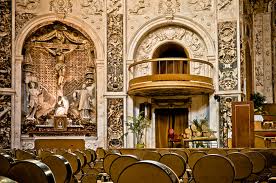
Read English version
Il monastero basiliano del SS. Salvatore e l’annessa chiesa vennero fondati alla fine dell’XI secolo, subito dopo la conquista normanna della città.
Nel 1528 l’antica chiesetta normanna venne riedificata in proporzioni più vaste suddivisa in tre navate e con la facciata rivolta sull’attuale salita del SS. Salvatore. Il vasto vuoto sopra il semplice portale lascia supporre che il prospetto sia rimasto incompiuto. Nel ’43 dopo un bombardamento l’interno venne totalmente distrutto e finirono in polvere tutte le decorazioni marmoree e in stucco comprese quelle della cupola. La chiesa conteneva numerose opere d’arte in parte andate distrutte. La pianta dell’edificio è un dodecagono allungato, circoscritto da un’ellisse il cui asse maggiore è una continuazione del centro dell’ingresso. Le pareti della chiesa sono riccamente decorate da preziosi marmi policromi siciliani del maestro Salvatore Allegra e, più in alto, al limite della cupola, dagli stucchi del maestro Francesco Alaimo. All’interno vi sono tre cappelle di cui la più ampia è sovrastata da una piccola cupola affrescata da Filippo Tancredi. Gli affreschi che si trovano alle pareti dello scalone d’ingresso appartengono al pittore Vito D’Anna e raffigurano due episodi della viTa di San Basilio: la guarigione di un bambino e la predicazione del Santo. Al pittore Vito D’Anna appartiene anche l’affresco della cupola, che riproduce la “Gloria di San Basilio”. Di notevole pregio è il gruppo marmoreo che raffigura il Cristo Crocifisso tra l’arcangelo Michele, San Gaetano e Santa Maria Maddalena. La grande tela che sovrasta l’attuale area presbiterale, raffigura “l’incoronazione di Santa Rosalia vergine palermitana”; é un’opera del Cedri, del 1725, che anticamente si trovava nel Monastero Benedettino di Santa Rosalia, abbattuto all’inizio del secolo scorso per dare luogo al prolungamento della Via Roma.
Nel 1528 l’antica chiesetta normanna venne riedificata in proporzioni più vaste suddivisa in tre navate e con la facciata rivolta sull’attuale salita del SS. Salvatore. Il vasto vuoto sopra il semplice portale lascia supporre che il prospetto sia rimasto incompiuto. Nel ’43 dopo un bombardamento l’interno venne totalmente distrutto e finirono in polvere tutte le decorazioni marmoree e in stucco comprese quelle della cupola. La chiesa conteneva numerose opere d’arte in parte andate distrutte. La pianta dell’edificio è un dodecagono allungato, circoscritto da un’ellisse il cui asse maggiore è una continuazione del centro dell’ingresso. Le pareti della chiesa sono riccamente decorate da preziosi marmi policromi siciliani del maestro Salvatore Allegra e, più in alto, al limite della cupola, dagli stucchi del maestro Francesco Alaimo. All’interno vi sono tre cappelle di cui la più ampia è sovrastata da una piccola cupola affrescata da Filippo Tancredi. Gli affreschi che si trovano alle pareti dello scalone d’ingresso appartengono al pittore Vito D’Anna e raffigurano due episodi della viTa di San Basilio: la guarigione di un bambino e la predicazione del Santo. Al pittore Vito D’Anna appartiene anche l’affresco della cupola, che riproduce la “Gloria di San Basilio”. Di notevole pregio è il gruppo marmoreo che raffigura il Cristo Crocifisso tra l’arcangelo Michele, San Gaetano e Santa Maria Maddalena. La grande tela che sovrasta l’attuale area presbiterale, raffigura “l’incoronazione di Santa Rosalia vergine palermitana”; é un’opera del Cedri, del 1725, che anticamente si trovava nel Monastero Benedettino di Santa Rosalia, abbattuto all’inizio del secolo scorso per dare luogo al prolungamento della Via Roma.
Oggi la chiesa, per quanto priva delle opere d’arte che l’arricchivano nel passato, si presenta, almeno parzialmente, nel suo antico splendore.
-
Visita: tutti i giorni dalle 10.00 alle 18.00 ticket
- Visita cupola: tutti i giorni dalle 10.00 alle 18.00 ticket Contatti:Tel. 327 3484439 – 329 1186212
*ENGLISH
The basilean monastery of SS. Salvatore and the annexed church were founded at the end of the eleventh century, just after the Norman conquest of the old town.
A larger old Norman church was completely rebuilt in 1528, it was subdivided into three aisles and its facade faced the current SS. Salvatore.
The large void above the simple portal seems to indicate that the prospectus has been left unfinished. In 1943 after a heavy bombing, the interior of the church was totally destroyed and all marble and stucco decorations including those of the dome were shattered.
The church housed many works of art, which were partially destroyed.
The building plan is an elongated twelve-dimensional dodecagon, circumscribed by an ellipse whose major axis is from the middle of the entrance.
The walls of the church are richly decorated with precious Sicilian polychrome marbles by the master Salvatore Allegra and, above, the dome ceiling is decorated with the stuccoes by the master Francesco Alaimo.
Inside there are three chapels, the largest one is dominated by a small dome frescoed by Filippo Tancredi. The frescoes on the walls of the entrance staircase belong to the painter Vito D’Anna and depict two episodes of St. Basil’s life: the healing of a child and the preaching of the Saint. The fresco of the dome, which reproduces the “Glory of St. Basil”, also belongs to the painter Vito D’Anna. Of great value is the marble group representing the Crucified Christ between the Archangel Michael, San Gaetano and Santa Maria Maddalena. The great canvas that overlooks the present presbytery area depicts “the coronation of Santa Rosalia, Palermitan Virgin”. It is a work by Cedri, created in 1725, which was formerly housed in the Benedictine Monastery of Santa Rosalia, cut down at the beginning of the last century to give way to the extension of Via Roma. Today, however deprived of the works of art that enriched it in the past, the church appears, at least partially, in its ancient splendor.
- Visit Oratory: click here
- Visit Dome: click here
- Ticket. Contacts: Tel. 327 3484439 – 329 1186212
